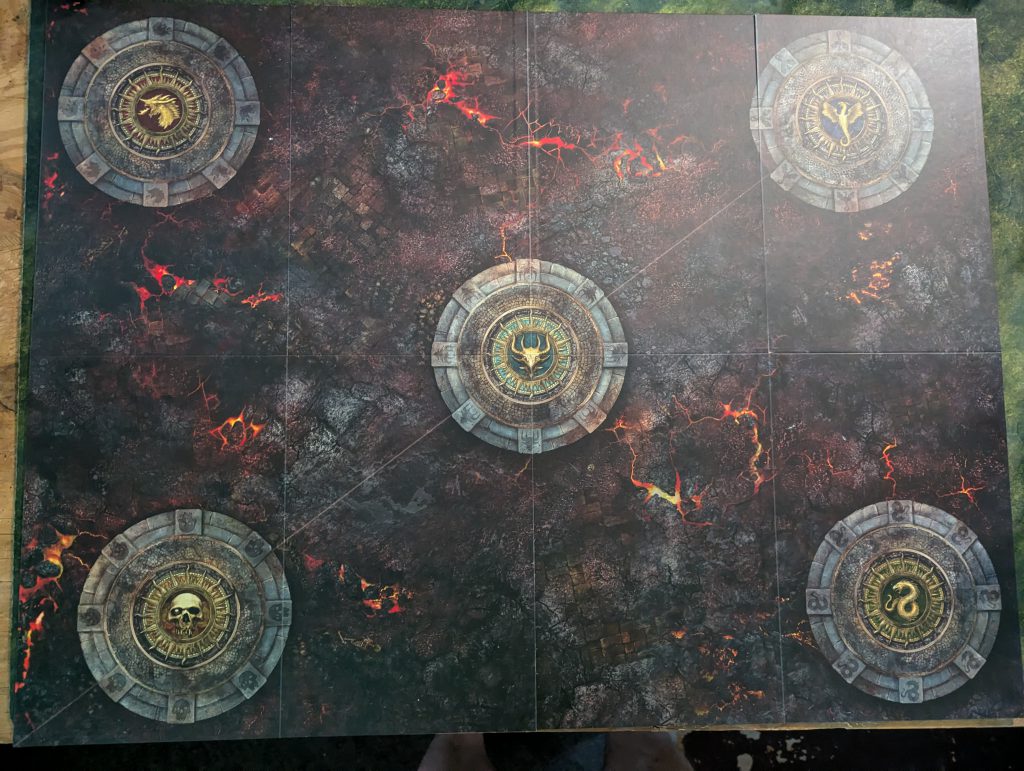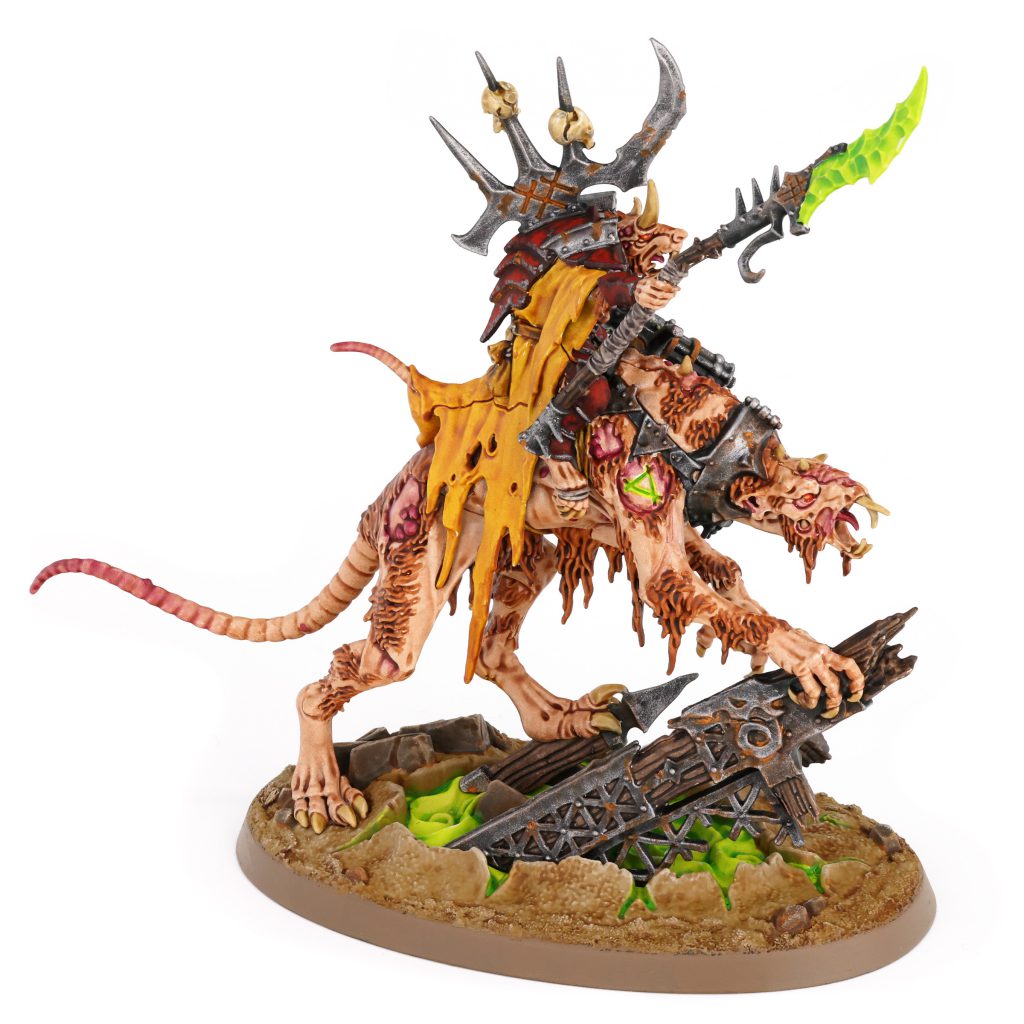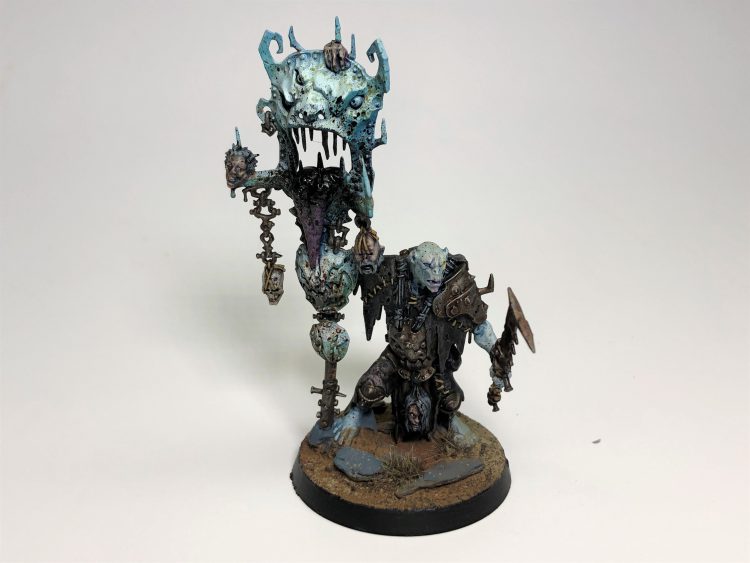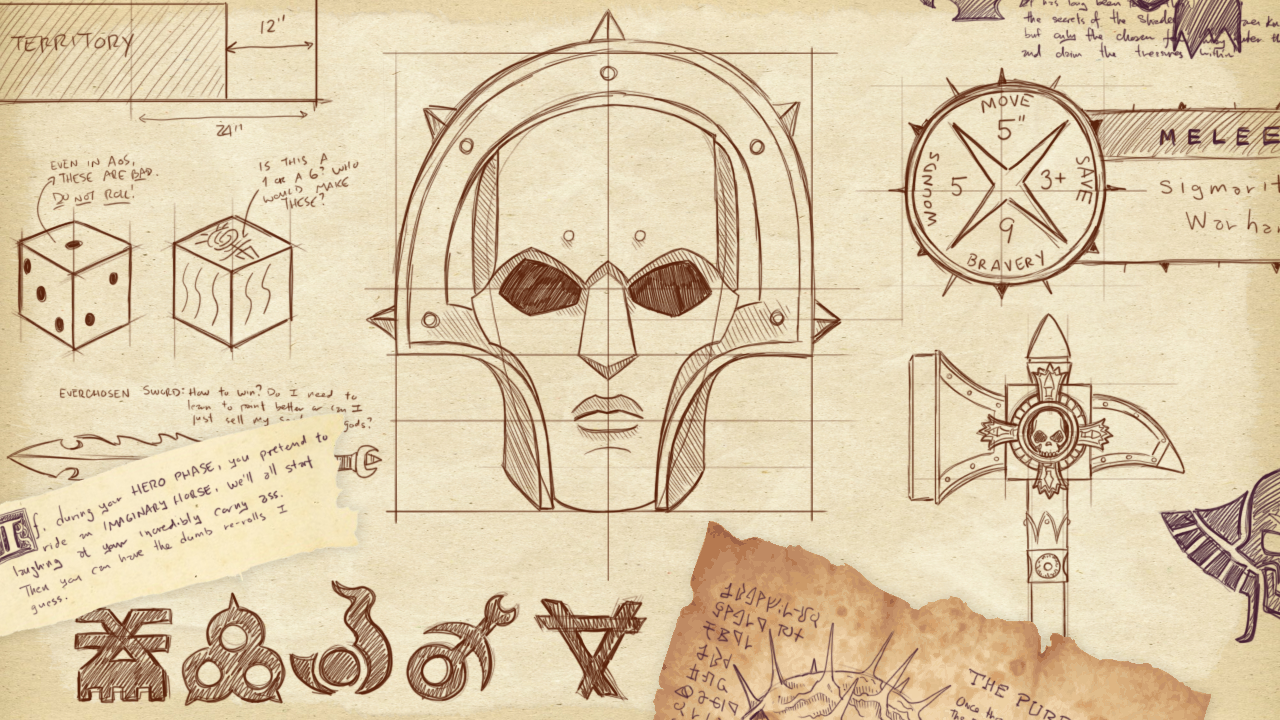A thank you to Games Workshop for sending us Fire and Jade as part of the Skaventide box set to be able to cover and review.
Fire and Jade is the rulebook that covers Spearhead in Age of Sigmar. In this article we’ll go over the contents of the book and discuss how some factions perform at an extremely high level. With over 25 different Spearheads (Skaven and Stormcast each get two) we’re going to be following up in the coming weeks with more spearhead specific content to supplement what we’ve already shared with you:
Gettings Started with Spearhead
Goonhammer Plays Spearhead at Dallas
Dallas Spearhead Event Results
The Book
The book itself is divided into the general rules for Spearhead, each Spearhead’s specific rules, and the core rules for the format. The art and photos are very functional, and the simplified Spearhead warscrolls always have a picture of some of the models in the unit, making identifying them extremely easy, since most Spearheads are constructed with a hero, an infantry unit, and elite unit (cavalry, heavy infantry, or shooting) and a larger unit (artillery or monster). This book is all you need (in addition to the cards, models, and board) and it is very easy see the rules for other spearheads that you don’t have.

The choice to make the book a hardbound book instead of a softbound book speaks to the confidence that GW has in the Spearhead game. Unlike Warcry there isn’t a specific spearhead story or reason that these forces are fighting on a smaller scale. One of the best touches is that every single Spearhead has a full picture and some credit given to a Games Workshop employee who painted the models. Some of these more or less follow the box art but others, like the KO and Daughters of Khaine, are very different from what Games Workshop typically shows in official printed material. If you were expecting a narrative book like the Dawnbringers or War in Thondia Fire and Jade is going to be disappointing since it is focused on providing the rules and getting out of the way. Sometimes when Games Workshop is attempting to justify why all the forces are fighting in a specific play you can feel the plot engine working overtime to justify why Kruleboyz are fighting vampires in a haunted forest.
The Rules
We covered the Spearhead rules in this article but our focus today is how each Spearhead feels. Generally, the factions feel how longtime Age of Sigmar factions would expect play at a smaller scale. However, based on some of the faction focus articles we’ve seen some of the factions have core abilities that aren’t reflected in the new edition of armies. Additionally, both Stormcast and Skaven Spearheads have completely different enhancements and abilities so as new Spearheads are released they will be written from the ground up.
Each faction has one or more battle traits, a choice between a regiment ability, and four Enhancements that can be taken by the general. Some of the regiment abilities, like the Stormcast Yndrasta’s Spearhead or Ogor Mawtribes Tyrant’s Bellow, and purely negative and keep your units off the board until a later battle round. This is disappointing as a player but allows the Spearheads to be balanced. Unit sizes are also not consistent with what is in the Age of Sigmar main game. Stabbas and Clanrats are in blocks of ten instead of twenty and several units with ten models are split into five model units. It doesn’t matter how these are split in most cases but for some odd-numbered units (like Blissbard Archers) the warscroll will specify any changes. With that- here is a short discussion of each Spearhead. In the context of Spearhead reinforcement refers to the unit coming back at full strength, not changing the starting size of the unit.
Order
Vigilant Brotherhood (Stormcast Eternals) – Incredibly mobile, this force needs to remove your opponents models quickly. Having two reinforced units is helpful.
Yndrastra’s Spearhead (Stormcast Eternals) This Spearhead plays exactly like you expect Stormcast to fight: A small group fighting against the odds before a nearly unstoppable save occurs.

Castelite Company (Cities of Sigmar) The battle trait, using the command on a card without discarding it, plays into the spearhead rules very well. Knowing the cards and what is remaining in your deck makes this an extremely skill based mechanic.
Starscale Warhost (Seraphon) This Seraphon Spearhead plays differently from the core army and doesn’t have any magical abilities. It is focused on getting in combat and dealing damage.
Glittering Phalanx (Lumineth Realmlords) This Spearhead feels a little weird with a horde-style elf faction that is infantry-focused. It has three reinforceable units and a host of abilities that feel like spells. The shining company, giving -1 to hit, is extremely powerful in Spearhead.
Heartflayer Troupe (Daughters of Khaine) This spearhead really feels like playing a Daughters of Khaine army in the last edition. Zealous Orator gives a third edition 5+ rally and the Witch Aelves are a mini blender unit in this format.
Soulraid Hunt (Idoneth Deepkin) Having two fast units in the Morrsarr Guard and Akhelian Allopex opens up a lot of bonus scoring from the tactics deck. The rules feel very thematic for Deepkin.
Bitterbark Copse (Sylvaneth) The Treelord is the star of this Spearhead that feels like a mini version of the popular “Kurnoth Shooting” list from the prior edition.
Skyhammer Task Force (Skyhammer Task Force) While the Frigate is the centerpiece of the faction ability the real star of this force is the Skywardens “Timed Charges” ability – the smaller board makes units with a high movement value retreating incredibly valuable for getting objectives.
Sage Axeband (Fyreslayers) Picking the right runes to activate and positioning this force is important. While you don’t have any reinforceable units you can get an enhancement to returng models in the hero phase.
Chaos
Warpspark Clawpack (Skaven) Thematically, this feels like Skaven should and three clawsteps ahead, letting you move in your opponents phase, is a great ability. The inclusion two of the most iconic Skaven units, Stormfiends and the Warp Lighting Cannon, is a great choice.
Gnawfeast Clawpack (Skaven) With six units this feels like on of the more beginner friendly Spearheads. It’s a good think it is located in the Skaventide box and the way they have incorporated the “gnawhole” ability without the gnawhole is great.

Bloodwind Legion (Slaves to Darkness) This is an Ok selection of Slaves to Darkness warscrolls that has the feel of a professional army. It’s a strong and tanky set of units that can’t be reinforced. However, it does take some of the most generic units from a very large and diverse army and the rules reflect this.
Bloodbound Gore Pilgrims (Khorne) This Spearhead gets to have a very limited bloodtithe that allows for extra rend or murderlust. It’s one of the few factions where you like to see a lot of reinforceable units on the other side.
Fluxblade Coven (Tzeentch) This is a six unit Spearhead with multiple fast units. Destiny dice are even more impactful with only four rounds and smaller model counts. Considering that Spearhead doesn’t use the “magic” section of the advanced rules the rules feel like a Tzeentch force.
Bleak Host (Nurgle) Everyone has a 5+ ward and the Blightkings are one of best infantry units in spearhead. Disease isn’t counted on a per unit basis and is kept in a pool (maximum of 7) that can be spent at the end of the turn to inflict mortal damage. It’s a good way to keep the Nurgle flavor without adding extra counters to every model in the game.
Blades of the Lurid Dream (Slaanesh) This is a fast army that incorporates the old temptation dice mechanic from third edition. Rejecting rolls feels extremely powerful as you could be doing 6D3 mortal damage in each battle round. Most armies have between 40-60 total health before accounting for reinforcements.
Death
Tithe-Reaper Echelon (Ossiarch Bonereapers) One of your mortek guard units are set up and won’t arrive until the third battle round. Additionally, you have a version of “command points” that give access to certain Ossiarch commands. This army really feels like a mini version of the standard Ossiarch Bonereapers army.
Bloodcrave Hunt (Soulblight Gravelords) Another death army that won’t field all the models until the third battle round. This Spearhead doesn’t have any reinforceable units but you can choose enhancements that let you bring back a single skeleton unit.
Slasher Host (Nighthaunt) Everything is an infantry unit that hits on a 4 so anything that can give a -1 to hit is going to cause problems for this Nighthaunt army. However, with six units that all get deployed on the first turn you should compete on the objectives very well.
Carrion Retainers (Flesh-eater Courts) There is a version of noble deed points but the Morbheg Knights having retreat and charge makes them in incredible unit. The smaller board sizes and bonus they receive from charging makes them the real stars of the Spearhead.
Destruction
Swampskulka Gang (Kruleboyz) With six units, two of them strong shooting units, and all non-companion melee attacks having Crit (Mortal) this army feels powerful in Spearhead. It has a little bit everything, from bonuses to control, to -1 to hit debuffs, to retreat and charge, to a retreat and charge on any unit.

Bad Moon Madmob (Gloomspite Gitz) At the Dallas event this Spearhead was played by a few players who were undefeated and it contains six units that all feel strong individually and have strong recursive abilities.
Tyrant’s Bellow (Ogor Mawtribes) This Spearhead has two key units, the Mournfang Pack and Ironblaster, off the battlefield. The warscrolls are all great but the abilities don’t give the “ogor” feel. At the smaller scale having mortals happen with every charge is likely hard to balance as the units themselves are extremely strong in a fight.
Wallsmasher Stop (Sons of Behemat) Instead of a Vanguard box this has Three Mancrushers – each can take advantage of reinforcement. Because of the 5+ save they aren’t as intimidating as you would think and this is a fun army to fight against since you get to use all of your abilities trying to stop these lads.
How to Choose What to Play in Jade and Fire
When it comes to miniature games, the rule of cool is always the best way to pick a faction or army. If you’re playing with a new player, or learning to play yourself, none of the armies in the Jade and Fire are so unbalanced that you won’t to try again. Some, like the Vigilant Brotherhood in the Spearhead box, might require a few games to understand how to win against certain matchups. Armies that are more or less straightforward to play, and good for the first time playing spearhead, are Gloomspite Gitz, Daughters of Khaine, the Gnawfeast Clawpack, or the Starscale Warhost. Armies that feel like they would reward players who have memorized the tactics deck are Cities of Sigmar, Kharadron Overlords, or Fyreslayers.
Final Thoughts
Ironjawz players are likely disappointed that they don’t have a Spearhead box, or rules yet in the Fire and Jade book. However, this game mode is intended to be supported throughout the edition with new Spearheads being released for each faction. With all the new information coming from this release Goonhammer is going to cover how to build and paint each Spearhead and how they play on the table in more detail.
Have any questions or feedback? Drop us a note in the comments below or email us at contact@goonhammer.com. Want articles like this linked in your inbox every Monday morning? Sign up for our newsletter. And don’t forget that you can support us on Patreon for backer rewards like early video content, Administratum access, an ad-free experience on our website and more.


